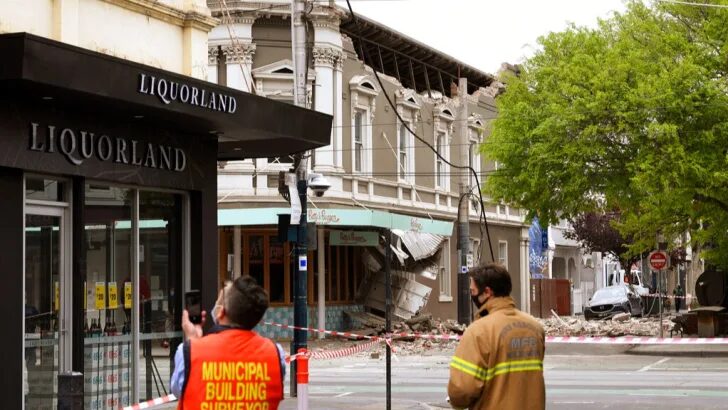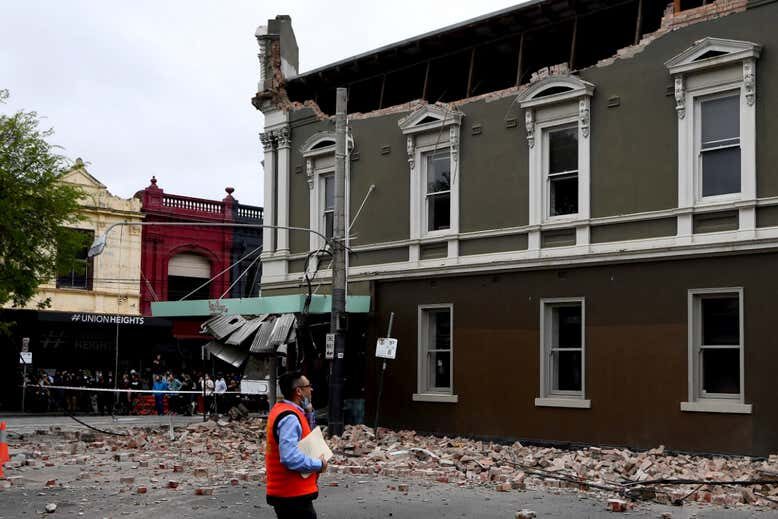
The magnitude 5.9 earthquake struck at 9:15am local time, according to Geoscience Australia. The epicentre was in the Alpine National Park about 120 kilometres east of Melbourne, at a shallow depth of around 10 kilometres.
People in Melbourne, who are currently in a covid-19 lockdown, reported feeling the ground shake for 15 to 20 seconds. Tremors were also felt in Canberra, just over 300 kilometres north-east of the epicentre.
A small number of buildings in Melbourne partially collapsed and power outages occurred in some parts of the city, but no major damage or serious injuries have been reported.
This is thanks to the epicentre occurring in a relatively remote region, says Dee Ninis at the Seismology Research Centre in Melbourne. "We're really lucky it wasn't in a populated area," she says
Australia experiences relatively few earthquakes because it sits in the middle of a tectonic plate, says Meghan Miller at the Australian National University in Canberra. "Countries like New Zealand, Indonesia and Japan are more at risk because they sit on plate boundaries," she says. "But it is a common fallacy that earthquakes don't happen in Australia."
One of Australia's worst earthquakes was a magnitude 5.6 earthquake in Newcastle in New South Wales in 1989, which caused extensive damage and killed 13 people.
Earthquakes occur in Australia when the tectonic plate that it sits on rubs against others and stress is slowly transmitted through the plate, eventually leading to a pressure build-up that causes a fault within the plate to rupture, says Phil Cummins, also at the Australian National University.

A magnitude 4.1 aftershock was recorded 15 minutes after this morning's earthquake, but Cummins expects there will be no more big aftershocks. Australia's Bureau of Meteorology has also deemed that there is no tsunami risk.
The earthquake was the largest to hit Australia since a magnitude 6.6 earthquake struck 130 miles off the northwest coastal town of Broome in 2019.



Comment: The timing of this unusually strong earthquake is notable because, after many months of increasingly oppressive lockdown restrictions, just a few days ago Australia saw an eruption of protests ignited by the enforcement of vaccine mandates: Melbourne police fire pepper balls at thousands of protesters amidst growing discontent over vaccine mandates & endless lockdowns
The pattern of significant phenomena such as earthquakes, record rainfalls, meteor fireball events, and so on, amidst peaks of societal upheaval is becoming ever more apparent.
To further illustrate the point: about 15 days ago there was a significant M7.1 earthquake in Mexico that just happened to be the anniversary of an even larger M8.2 that rocked the country on the same date in 2017. In the run-up to the day many Mexicans reported feeling anxiety that a similarly large and devastating quake might occur; thankfully for them, the quake was not as destructive. A similar sequence was noted with the M8.0 quake on September 19th 1985 which was echoed in an M7.1 on the same date in 2017:
Rocks the size of small houses break off during landslide near Mexico City, 1 dead, 10 missing
For more on Earth Changes and the Human-Cosmic Connection, check out SOTT radio's:
- MindMatters: The Holy Grail, Comets, Earth Changes and Randall Carlson
- Adapt 2030 Ice Age Report: Interview with Laura Knight-Jadczyk and Pierre Lescaudron
As well as Pierre Lescaudron and Laura Knight-Jadczyk's book the subject: Earth Changes and the Human-Cosmic Connection